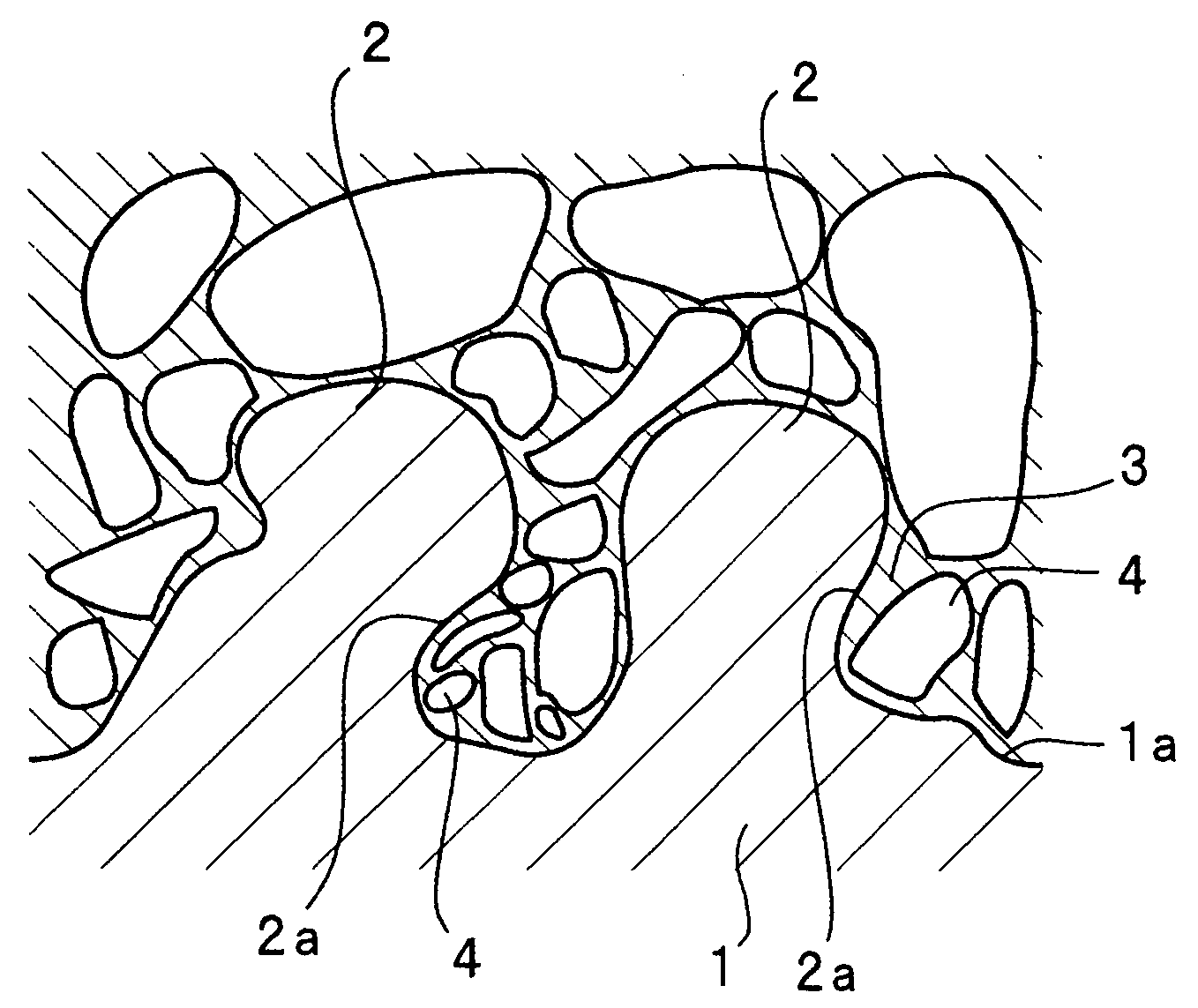Negative electrode for rechargeable lithium battery and method for fabrication thereof
a technology of lithium battery and negative electrode, which is applied in the direction of electrode manufacturing process, cell components, instruments, etc., can solve the problems of reducing the current-collecting capacity of the electrode, poor charge-discharge cycle characteristics, and the expansion and shrinkage of the volume of the silicon material and other lithium-alloying materials, so as to reduce the current-collecting capacity and improve the cycle performance characteristics. , the effect of reducing the current-collecting capacity
- Summary
- Abstract
- Description
- Claims
- Application Information
AI Technical Summary
Benefits of technology
Problems solved by technology
Method used
Image
Examples
experiment 1
[0053](Fabrication of Negative Electrode)
[0054]81.8 parts by weight of a silicon powder (99.9% pure) having a mean particle diameter of 3 μm and an 8.6 wt. % N-methylpyrrolidone solution containing 18.2 parts by weight of polyimide as a binder were mixed to provide an anode mix slurry.
[0055]This anode mix slurry was coated on one surface (rough surface) of a cover-plated electrolytic copper foil (35 μm thick) (current collector al) having a surface roughness Ra of 1.0 μm and then dried. A 25 mm×30 mm rectangle piece was cut out from the coated copper foil, calendered and then sintered by a heat treatment under argon atmosphere at 400° C. for 30 hours to provide a negative electrode. The sintered body (inclusive of the current collector) was 50 μm thick. Accordingly, the thickness of the anode mix layer was 15 μm, anode mix layer thickness / copper foil surface roughness was 15, and anode mix layer thickness / copper foil thickness was 0.43.
[0056]In the negative electrode, polyimide was ...
experiment 2
[0067]In place of the current collector a1, an electrolytic copper foil (current collector b1) having a surface roughness Ra of 1.0 μm was used. No cover plating was applied thereto. Otherwise, the procedure of Experiment 1 was followed to construct a battery B1.
[0068]FIG. 5 is a sectional view of the current collector b1 when observed by an SEM (with a magnification of 2000×).
[0069](Evaluation of Charge-Discharge Cycle Characteristics)
[0070]The above-constructed batteries A1 and B1 were evaluated for charge-discharge cycle performance characteristics. Each battery was charged at 25° C. at a current of 14 mA to 4.2 V and then discharged at a current of 14 mA to 2.75 V. This was recorded as a unit cycle of charge and discharge. The battery was cycled to determine the number of cycles after which its discharge capacity fell down to 80% of its first-cycle discharge capacity and the determined cycle number was recorded as a cycle life. The results are shown in Table 1. The cycle life of...
experiment 3
[0073]In this Experiment, the effect of surface roughness Ra of the current collector on cycle characteristics was studied.
[0074]In place of the current collector a1, cover-plated electrolytic copper foils having different thickness values were used in Experiment 1. Specifically, an electrolytic copper foil (current collector a2) having a surface roughness Ra of 0.5 μm, an electrolytic copper foil (current collector a3) having a surface roughness Ra of 0.2 μm and an electrolytic copper foil (current collector a4) having a surface roughness Ra of 0.17 μm were used. Using these current collectors, the procedure of Experiment 1 was followed to construct batteries A2, A3 and A4.
[0075]The current collectors a2, a3 and a4 were fabricated via cover plating, as similar to the current collector a1, and each includes projections having recurved side face portions as shown in FIG. 4, in accordance with the present invention.
[0076]Each battery was evaluated for cycle characteristics in the same...
PUM
| Property | Measurement | Unit |
|---|---|---|
| surface roughness Ra | aaaaa | aaaaa |
| surface roughness | aaaaa | aaaaa |
| thickness | aaaaa | aaaaa |
Abstract
Description
Claims
Application Information
 Login to View More
Login to View More - R&D
- Intellectual Property
- Life Sciences
- Materials
- Tech Scout
- Unparalleled Data Quality
- Higher Quality Content
- 60% Fewer Hallucinations
Browse by: Latest US Patents, China's latest patents, Technical Efficacy Thesaurus, Application Domain, Technology Topic, Popular Technical Reports.
© 2025 PatSnap. All rights reserved.Legal|Privacy policy|Modern Slavery Act Transparency Statement|Sitemap|About US| Contact US: help@patsnap.com



